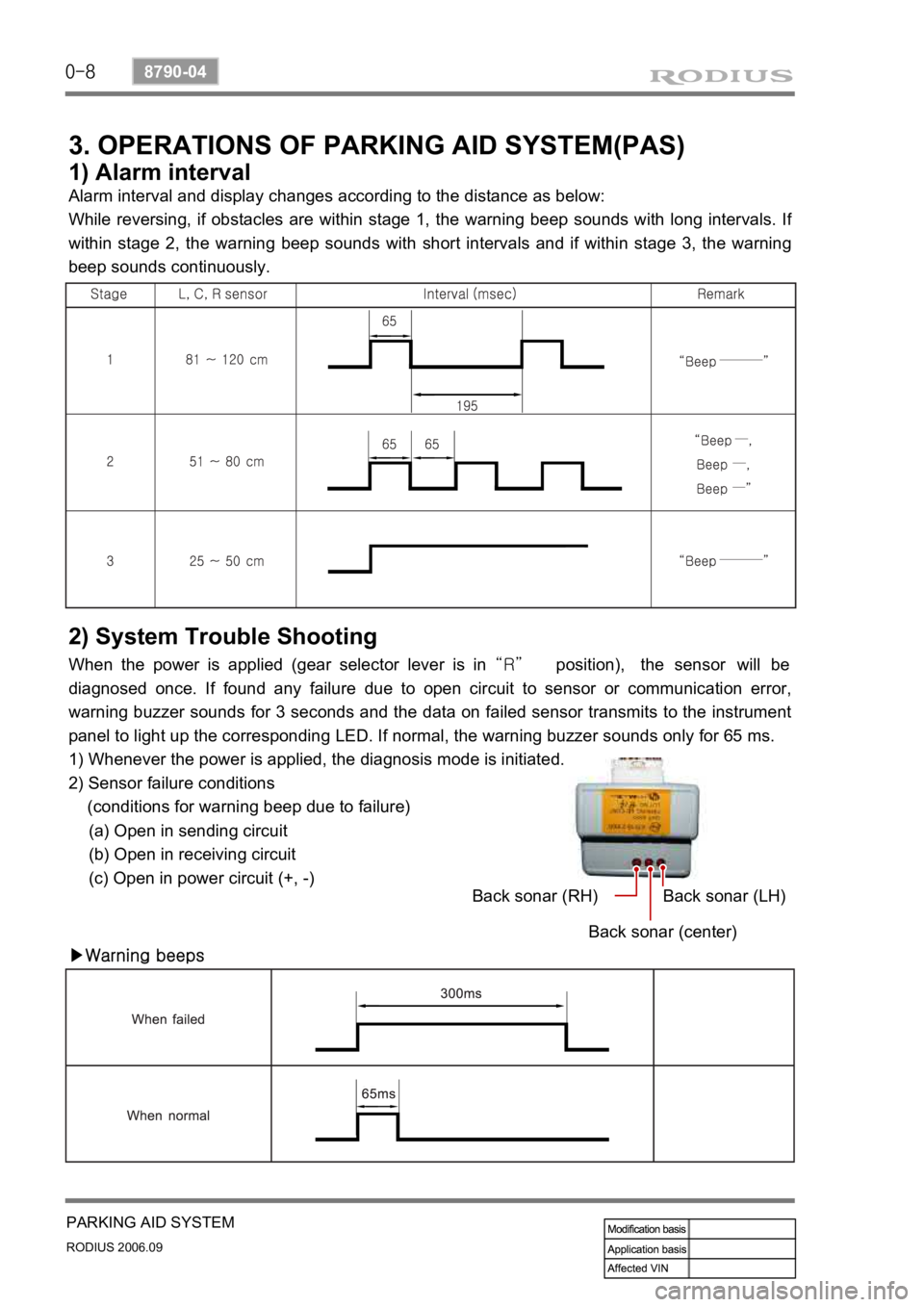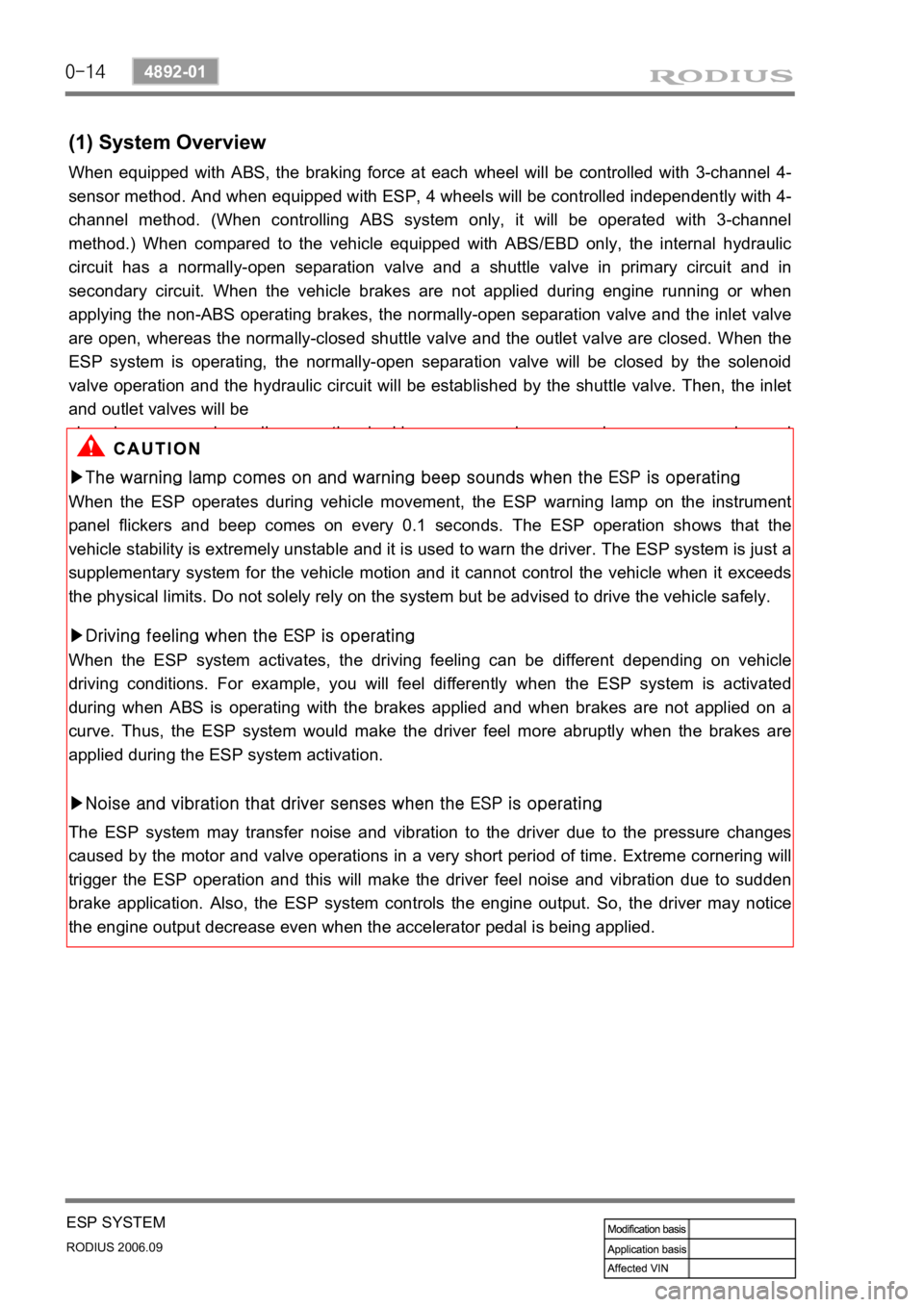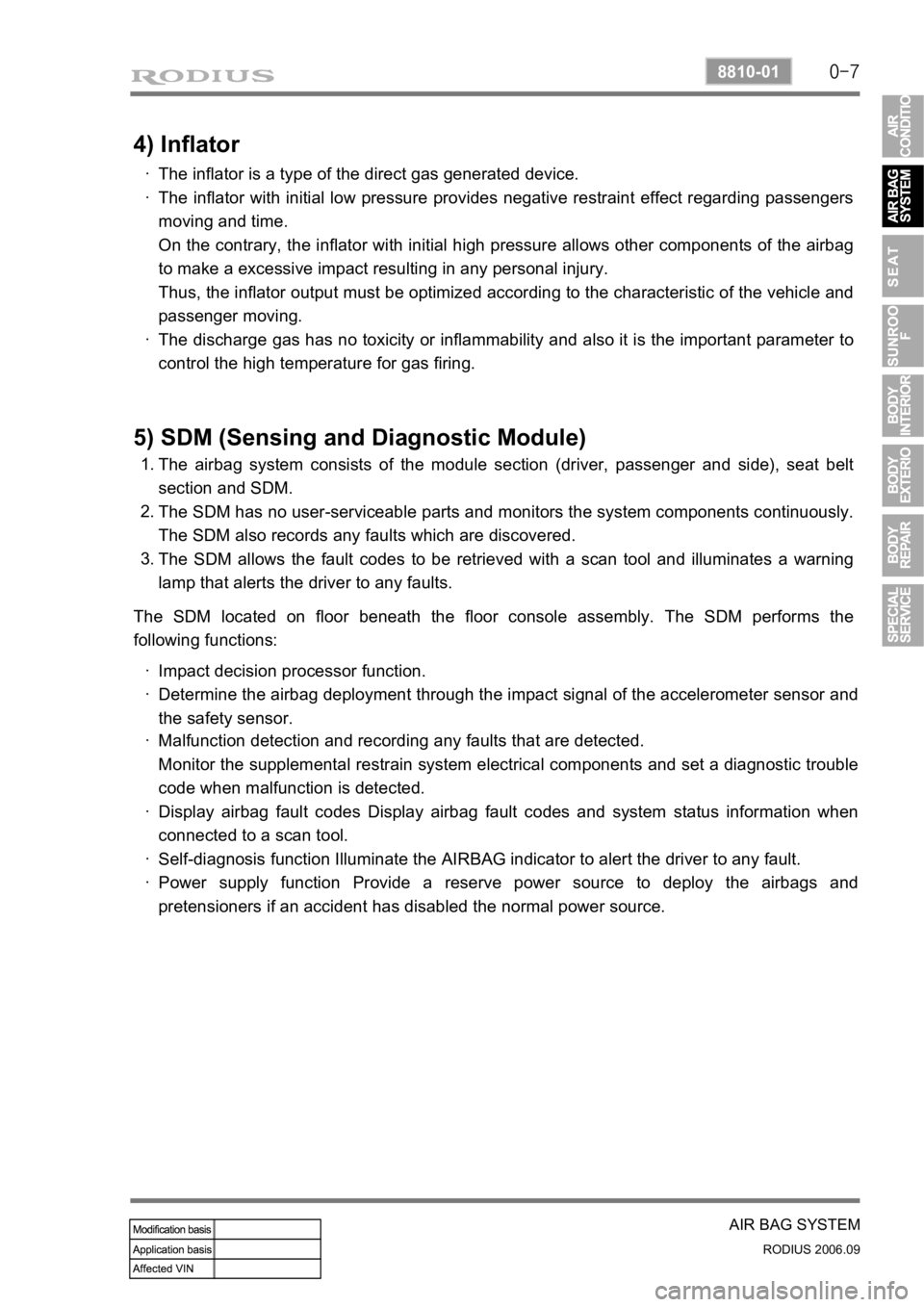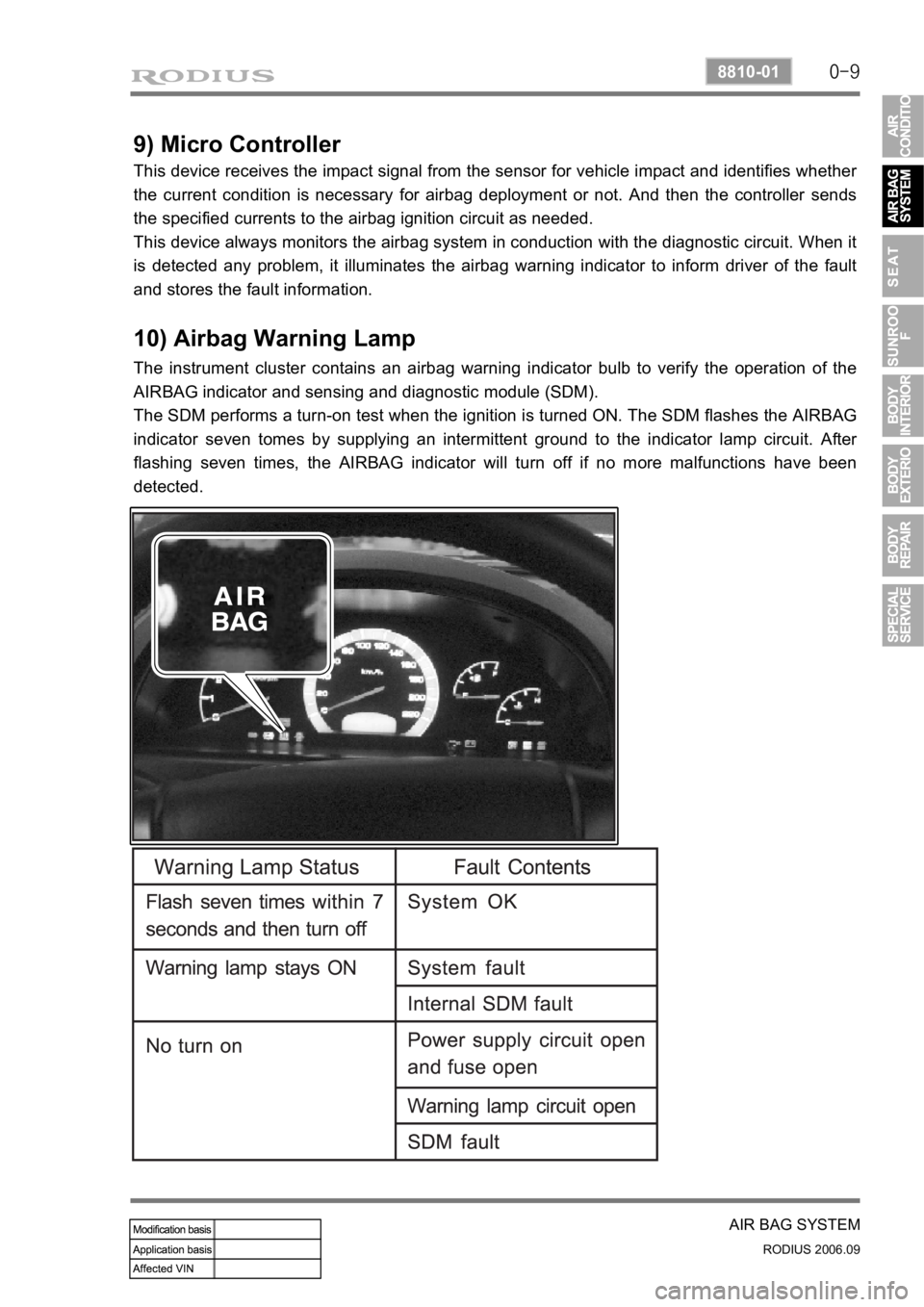Page 257 of 465

0-8
RODIUS 2006.09
8790-04
PARKING AID SYSTEM
3. OPERATIONS OF PARKING AID SYSTEM(PAS)
1) Alarm interval
Alarm interval and display changes according to the distance as below:
While reversing, if obstacles are within stage 1, the warning beep sounds with long intervals. I
f
within stage 2, the warning beep sounds with short intervals and if within stage 3, the warning
beep sounds continuously.
2) System Trouble Shooting
When the power is applied (gear selector lever is in “R” position), the sensor will be
diagnosed once. If found any failure due to open circuit to sensor or communication error,
warning buzzer sounds for 3 seconds and the data on failed sensor transmits to the instrument
panel to light up the corresponding LED. If normal, the warning buzzer sounds only for 65 ms.
1) Whenever the power is applied, the diagnosis mode is initiated.
2) Sensor failure conditions
(conditions for warning beep due to failure)
(a) Open in sending circuit
(b) Open in receiving circuit
(c) Open in power circuit (+, -)
▶Warning beepsBack sonar (RH)
Back sonar (center)Back sonar (LH)
Page 273 of 465
0-4
RODIUS 2006.09
3410-01
TRANSFER CASE
1. PART TIME TRANSFER CASE OVERVIEW
By using the planetary gear sets, two-gears shift type part time transfer case achieves direct
connection when selecting 4WD “HIGH” and 2.48 of reduction gear ratio when selecting
4WD “LOW”.
The silent chain in transfer case transfers the output power to front wheels.
Simple operation of switches on instrument panel allows to shift to “2H”, “4H” and “4L”
easily while driving.
The warning lamp alarms the driver when the system is defective.
Page 285 of 465
0-16
RODIUS 2006.09
3410-01
TRANSFER CASE
This function is only available when the speed signal from speed sensor is about to stop
(below 2 km/h).
This function is only available when clutch pedal is depressed (manual transmission) o
r
selector lever is selected to “N” position (automatic transmission).
(TCCU must recognize the clutch pedal signal or “N” signal.)
Change the 4WD switch in instrument panel from 4H to 4L.
“4WD LOW” warning lamp in meter cluster blinks during this process, then remains
when the shift is completed.
“4WD CHECK” warning lamp comes on when the system is defective. -
-
-
-
- 4H → 4L ▶
Page 286 of 465
0-17
TRANSFER CASE
RODIUS 2006.09
3410-01
8. SYSTEM OPERATION
1) Transfer Case Control Unit (Tccu)
(1) 4WD Operation
TCCU is located under the front left seat and
permits the vehicle to shift from two-wheel
drive to four-wheel drive (and back shift)
according to drivers switch operation during
driving (For the shifting between 4WD HIGH
and 4WD LOW, stop the vehicle).
2H → 4H ▶
Change the 4WD switch in instrument panel from 2H to 4H.
This shift is available during driving.
“4WD HIGH” indicator in meter cluster comes on. -
-
-
When the system is defective
“4WD CHECK” warning lamp comes
on -
Change the 4WD switch in instrument panel from 4H to 2H.
This shift is available during driving.
“4WD HIGH” indicator in meter cluster goes out.
“4WD CHECK” warning lamp comes on when the system is defective. -
-
-
- 4H → 2H ▶
Page 324 of 465
0-4
RODIUS 2006.09
4892-01
ESP SYSTEM
1. COMPONENTS AND LOCATIONS
2WD vehicle has the longitudinal sensor in the HECU.
1. HECU: (Hydraulic &
Engine conrol unit) 2. Pressure sensor 3. Wheel speed sensor
4. Sensor cluster:
(Yaw rate + lateral sensor + longitudinal sensor) 5. Steering wheel angle
sensor 6. ESP off switch (Electronic
Stability Program Switch) ESP Warning lamp
Page 334 of 465

0-14
RODIUS 2006.09
4892-01
ESP SYSTEM
(1) System Overview
When equipped with ABS, the braking force at each wheel will be controlled with 3-channel 4-
sensor method. And when equipped with ESP, 4 wheels will be controlled independently with 4-
channel method. (When controlling ABS system only, it will be operated with 3-channel
method.) When compared to the vehicle equipped with ABS/EBD only, the internal hydraulic
circuit has a normally-open separation valve and a shuttle valve in primary circuit and in
secondary circuit. When the vehicle brakes are not applied during engine running or when
applying the non-ABS operating brakes, the normally-open separation valve and the inlet valve
are open, whereas the normally-closed shuttle valve and the outlet valve are closed. When the
ESP system is operating, the normally-open separation valve will be closed by the solenoid
valve operation and the hydraulic circuit will be established by the shuttle valve. Then, the inlet
and outlet valves will be
closed or open depending on the braking pressure increase, decrease or unchanged
conditions.
<0d96007b008f008c0047009e00880099009500900095008e004700930088009400970047008a00960094008c009a004700960095004700880095008b0047009e00880099009500900095008e00470089008c008c00970047009a0096009c0095008b009a00
47009e008f008c00950047009b008f008c0047006c007a0077> is operating
▶Driving feeling when the ESP is operating
<0d96007500960090009a008c004700880095008b0047009d0090008900990088009b0090009600950047009b008f0088009b0047008b00990090009d008c00990047009a008c0095009a008c009a0047009e008f008c00950047009b008f008c0047006c00
7a007700470090009a004700960097008c00990088009b0090>ng When the ESP operates during vehicle movement, the ESP warning lamp on the instrument
panel flickers and beep comes on every 0.1 seconds. The ESP operation shows that the
vehicle stability is extremely unstable and it is used to warn the driver. The ESP system is just a
supplementary system for the vehicle motion and it cannot control the vehicle when it exceeds
the physical limits. Do not solely rely on the system but be advised to drive the vehicle safely.
When the ESP system activates, the driving feeling can be different depending on vehicle
driving conditions. For example, you will feel differently when the ESP system is activated
during when ABS is operating with the brakes applied and when brakes are not applied on a
curve. Thus, the ESP system would make the driver feel more abruptly when the brakes are
applied during the ESP system activation.
The ESP system may transfer noise and vibration to the driver due to the pressure changes
caused by the motor and valve operations in a very short period of time. Extreme cornering will
trigger the ESP operation and this will make the driver feel noise and vibration due to sudden
brake application. Also, the ESP system controls the engine output. So, the driver may notice
the engine output decrease even when the accelerator pedal is being applied.
Page 407 of 465

0-7
AIR BAG SYSTEM
RODIUS 2006.09
8810-01
4) Inflator
The inflator is a type of the direct gas generated device.
The inflator with initial low pressure provides negative restraint effect regarding passengers
moving and time.
On the contrary, the inflator with initial high pressure allows other components of the airbag
to make a excessive impact resulting in any personal injury.
Thus, the inflator output must be optimized according to the characteristic of the vehicle and
passenger moving.
The discharge gas has no toxicity or inflammability and also it is the important parameter to
control the high temperature for gas firing. ·
·
·
5) SDM (Sensing and Diagnostic Module)
The airbag system consists of the module section (driver, passenger and side), seat belt
section and SDM.
The SDM has no user-serviceable parts and monitors the system components continuously.
The SDM also records any faults which are discovered.
The SDM allows the fault codes to be retrieved with a scan tool and illuminates a warning
lamp that alerts the driver to any faults. 1.
2.
3.
The SDM located on floor beneath the floor console assembly. The SDM performs the
following functions:
Impact decision processor function.
Determine the airbag deployment through the impact signal of the accelerometer sensor and
the safety sensor. ·
·
Malfunction detection and recording any faults that are detected.
Monitor the supplemental restrain system electrical components and set a diagnostic trouble
code when malfunction is detected.
Display airbag fault codes Display airbag fault codes and system status information when
connected to a scan tool.
Self-diagnosis function Illuminate the AIRBAG indicator to alert the driver to any fault.
Power supply function Provide a reserve power source to deploy the airbags and
pretensioners if an accident has disabled the normal power source. ·
·
·
·
Page 409 of 465

0-9
AIR BAG SYSTEM
RODIUS 2006.09
8810-01
9) Micro Controller
This device receives the impact signal from the sensor for vehicle impact and identifies whether
the current condition is necessary for airbag deployment or not. And then the controller sends
the specified currents to the airbag ignition circuit as needed.
This device always monitors the airbag system in conduction with the diagnostic circuit. When it
is detected any problem, it illuminates the airbag warning indicator to inform driver of the fault
and stores the fault information.
10) Airbag Warning Lamp
The instrument cluster contains an airbag warning indicator bulb to verify the operation of the
AIRBAG indicator and sensing and diagnostic module (SDM).
The SDM performs a turn-on test when the ignition is turned ON. The SDM flashes the
AIRBAG
indicator seven tomes by supplying an intermittent ground to the indicator lamp circuit.
After
flashing seven times, the AIRBAG indicator will turn off if no more malfunctions have been
detected.